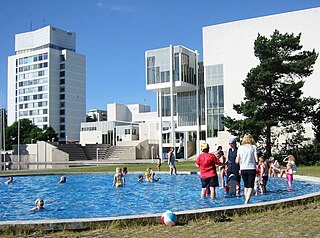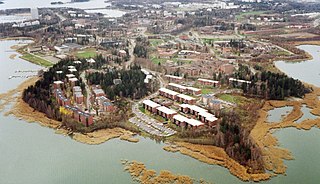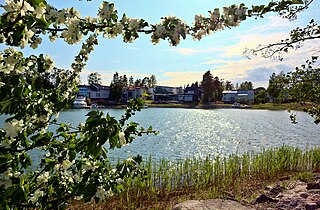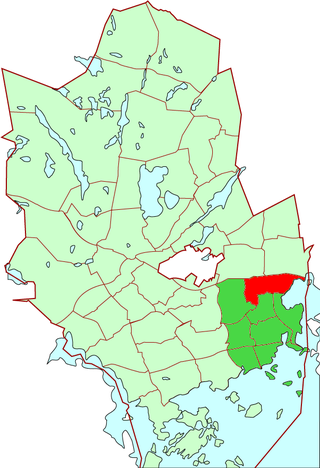
Vantaa is a city in Finland. It is located to the north of the capital, Helsinki, in southern Uusimaa. The population of Vantaa is approximately 247,000. It is the 4th most populous municipality in Finland. Vantaa is part of the Helsinki Metropolitan Area, which has approximately 1.58 million inhabitants.

Espoo is a city in Finland. It is located to the west of the capital, Helsinki, in southern Uusimaa. The population is approximately 314,000. It is the 2nd most populous municipality in Finland. Espoo is part of the Helsinki Metropolitan Area, which has approximately 1.6 million inhabitants. Espoo is on the northern shore of the Gulf of Finland and borders Helsinki, Vantaa, Kirkkonummi, Vihti and Nurmijärvi. The city includes the enclave of Kauniainen. Espoo covers an area of 528 square kilometres (204 sq mi). Espoo is a bilingual municipality with Finnish and Swedish as its official languages. The population consists of 70% Finnish speakers, 6% Swedish speakers, and 24% speakers of other languages, well above the national average.

Kauniainen is a town in Finland, located in the southern interior of the country. Kauniainen is situated in the southern part of the Uusimaa region, and it is enclaved by the City of Espoo. The population of Kauniainen is approximately 10,000. It is the 95th most populous municipality in Finland. Kaunianen is part of the Helsinki Metropolitan Area, which has approximately 1.58 million inhabitants.

Tapiola is a district of the municipality of Espoo on the south coast of Finland, and is one of the major urban centres of Espoo. It is located in the western part of Helsinki capital region. The name Tapiola is derived from Tapio, who is the forest god of Finnish mythology, especially as expressed in the Kalevala.

Otaniemi (Finnish), or Otnäs (Swedish), is a district of Espoo, Finland. It is located near the border of Helsinki, the capital of Finland.

Lauttasaari is an island in Helsinki, Finland, about 3 kilometres (1.9 mi) west of the city centre. Together with some surrounding unpopulated small islands, Lauttasaari is also a district of Helsinki. With 23,226 residents as of 2017, the island is Finland's second largest by population, after Fasta Åland. Its land area is 3.85 km2.

Pähkinärinne is a suburb in Western Vantaa, in Finland. It lies roughly between a pond named Lammaslampi and Vihdintie, former Helsinki-Pori main road. It lies near the border between Vantaa and both Helsinki and Espoo.There are basic services, for example, a comprehensive school for students from 1st to 6th forms, in Pähkinärinne. Pähkinärinne neighbours Hämeenvaara, Hämeenkylä, Linnainen, Rajatorppa and Varisto.

Haukilahti is a neighbourhood in Espoo, Finland. It is located on the seashore of the Gulf of Finland in the southern part of the city.

Länsiväylä is a motorway in the Greater Helsinki area of Finland, mainly at the Helsinki conurbation. It is part of the Finnish national road 51. The road begins in Ruoholahti in western Helsinki and continues west through the island of Lauttasaari and then across the city border to Espoo. The Länsiväylä road continues all the way throughout the southern part of Espoo. It continues as a motorway until finally crossing the border west to Kirkkonummi.

The Finnish nobility was historically a privileged class in Finland, deriving from its period as part of Sweden and the Russian Empire. Noble families and their descendants are still a part of Finnish republican society, but except for the titles themselves, no longer retain any specific or granted privileges. A majority of Finnish nobles have traditionally been Swedish-speakers using their titles mostly in Swedish. The Finnish nobility today has some 6,000 male and female members.

Westend is a district of the city of Espoo, Finland. It is located next to Tapiola and about ten kilometers from the center of Helsinki. From Westend Helsinki can be reached along Länsiväylä. Known as an affluent area, Westend is the wealthiest postal code area of Finland by mean household income. In 2019, the area was home to more than 3,000 residents.

Tapiolan urheilupuisto is a sports park in the Tapiola district of Espoo, Finland. The park includes several sports halls and football pitches, as well as the multipurpose Espoo Metro Areena. The Urheilupuisto metro station, which connects the park to the Länsimetro, was opened in 2017.

The Espoo Cultural Centre is a culture centre in Tapiola, Espoo, Finland. It is most famous for hosting the central library of Tapiola. Near the culture centre is the Tapiola swimming pool and the Tapiola Garden hotel.

Keilaniemi is a district in the south-eastern part of Espoo, Finland.

Niittykumpu (Finnish) or Ängskulla (Swedish) is a district of Espoo, a city in Finland. The districts belongs to the major district of Suur-Tapiola. The district, partly located on the eastern lands of the former Gräsa manor, started developing along with the rest of southern Espoo in the 1930s when the street Jorvaksentie was completed. The first significant construction phase of Niittykumpu happened during the 1960s and 1970s, when a large number of terraced houses were built in the area because of rapid growth of the city of Espoo. Construction slowed down during the early 1990s depression in Finland. Construction picked up pace again in the 2000s and increased even further during the construction of the Länsimetro transport line.

Laajalahti is a district of Espoo, a city in Finland. It belongs to the area of Suur-Tapiola together with Westend, Tapiola, Pohjois-Tapiola, Otaniemi, Niittykumpu, Mankkaa, and Haukilahti. It gets its name from the bay on which it is located. Laajalahti belongs to three sectors; Laajaranta, Lupauksenvuori, and Ruukinranta.

Leppävaara is a district of Espoo, a city in Finland. The Rantarata rail line and the Ring Road I, the busiest road in Finland, cross in Leppävaara, thus making it a major traffic hub in the Greater Helsinki region. The Sello Shopping Centre is also located in Leppävaara.

Kino Tapiola is a movie theatre in Tapiola, Espoo, Finland, founded in 1955. The theatre is one of the few original old-style movie theatres in the Helsinki capital area still remaining in its own, culturally protected state. The theatre has one auditorium, with 194 places. The theatre activity is owned by Espoon elokuvajuhlat ry.

The Hagalund manor is a manor in Espoo, Finland located in the Tapiola and Otaniemi areas. It has been owned by the families of von Wright, von Numers, Sinebrychoff and Grahn.

Royal Espoo manor is a manor in the Espoonkartano district of Espoo, after which the district itself is named. It is historically the most significant of Espoo's manors. Espoo Manor's extensive landscape complex includes several culturally historically significant buildings.




















